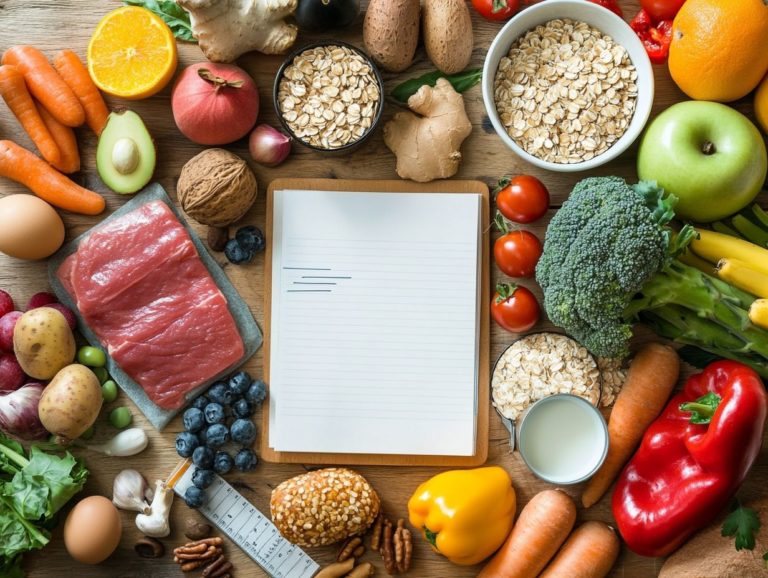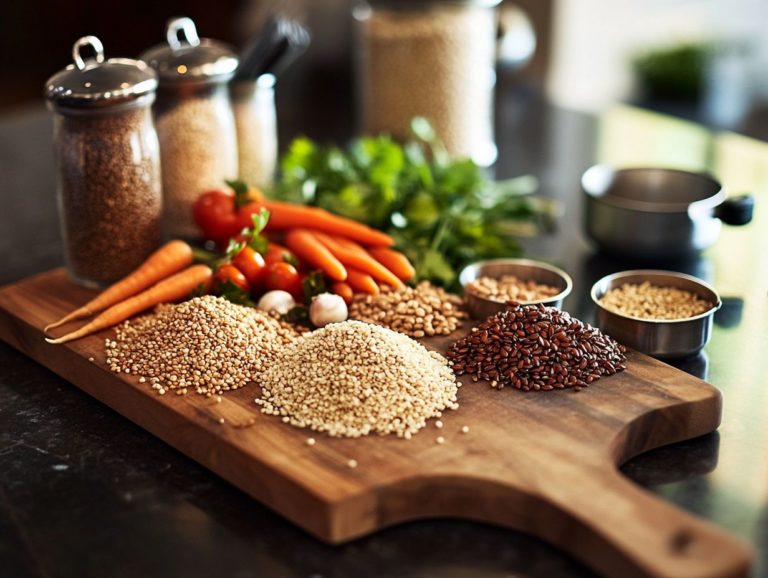How Do I Count Calories Properly?
Counting calories can be exciting once you get the hang of it! Grasping the fundamentals is vital for sustaining a healthy lifestyle.
This article delves into the essence of calories and the significance of monitoring them. You’ll discover the various factors that influence your calorie requirements, ranging from metabolism to dietary selections, along with practical tips for effectively tracking your intake.
We’ll also highlight common pitfalls to avoid and outline strategies for setting achievable goals. Join in as we demystify calorie counting and empower you on your nutritional journey.
Contents
- Key Takeaways:
- Understanding Calories
- Factors that Affect Calorie Intake
- How to Properly Count Calories
- Common Mistakes in Calorie Counting
- Tips for Successful Calorie Counting
- Preguntas Frecuentes
- 1. C mo cuento calor as correctamente?
- 2. Puedo comer cualquier cosa si me mantengo dentro de mi l mite de calor as?
- 3. C mo mido con precisi n mis porciones de comida?
- 4. Puedo omitir el seguimiento de calor as en d as de trampa?
- 5. Hay alimentos que no necesito contabilizar para las calor as?
- 6. Contar calor as es la nica forma de controlar mi peso?
Key Takeaways:

Understanding the concept of calories and their importance in weight management is essential for successful calorie counting. Factors such as metabolism, activity level, and dietary choices can greatly affect calorie intake and should be taken into consideration when counting calories.
Proper calorie counting involves using a food diary or tracking app, measuring and estimating portion sizes, and avoiding common mistakes such as underestimating portions and not accounting for hidden calories.
Start your journey today! The right calorie tracking can transform your health.
Understanding Calories
Understanding calories is paramount for achieving weight loss and maintaining a healthy body composition. As a unit of energy, calories are integral in determining your daily energy needs and play a pivotal role in weight management, whether your goal is to lose weight, gain it, or simply maintain your current status.
By accurately counting calories, establishing a targeted caloric intake, and diligently tracking your energy consumption, you can make informed food choices that align seamlessly with your health goals and dietary guidelines.
What are Calories?
Calories are essentially the energy units your body derives from food, vital for sustaining bodily functions and powering your physical activities. These energy units play a pivotal role in how your body utilizes nutrients for growth, repair, and overall health.
When you consume food, your body breaks down the three main types of nutrients in food: carbohydrates, proteins, and fats releasing calories that fuel your daily endeavors.
However, it’s important to remember that not all calories are equal; nutrient-dense foods like fruits, vegetables, and whole grains provide essential vitamins and minerals along with their calories, promoting better health.
On the flip side, calorie-dense options, often packed with added sugars or unhealthy fats, can deliver excessive energy without adequate nutrition. Understanding the difference between these types helps you make smarter dietary choices, which is essential for maintaining a balanced diet and achieving optimal well-being.
Importance of Calorie Counting
Calorie counting is an essential practice for anyone aiming to achieve specific weight loss or health goals, as it allows for precise tracking of energy intake and helps maintain adherence to a set calorie target.
By actively monitoring your calorie consumption through a food diary or utilizing various tracking apps, you can develop a deeper understanding of your dietary habits. This awareness is crucial for making informed choices that align with your personal health objectives.
Grasping the caloric contribution of different foods gives you the power to plan meals more effectively, ultimately helping you manage your overall energy intake. Whether you re just starting out or are a seasoned dieter, this method helps you stay accountable and encourages a balanced diet rich in essential nutrients.
Factors that Affect Calorie Intake
Many factors influence how many calories you need, including your metabolism, activity level, and food choices. Each of these elements plays a pivotal role in shaping your overall energy needs and effective weight management strategies.
Understanding this interplay can give you the power to make informed decisions about your nutrition and lifestyle.
Metabolism and Activity Level

Metabolism encompasses the biochemical processes that transform food into energy. It plays a crucial role in determining your calorie intake and energy expenditure based on your activity level.
This system isn’t just about how much you eat. It also changes with physical activity, age, and body composition.
If you lead a sedentary lifestyle, your body’s energy expenditure is likely to be lower. This means you require fewer calories to maintain your weight.
On the other hand, if you engage in regular exercise be it cardio, strength training, or high-intensity workouts you’ll often notice an uptick in your metabolic rate. This results in higher energy needs.
Grasping these dynamics is vital for optimizing your nutrition and meeting your fitness goals. Striking the right balance between calorie intake and energy expenditure ensures that your body operates efficiently and stays healthy.
Dietary Choices
Your dietary choices significantly influence your calorie intake. By selecting healthy foods instead of high-calorie options, you can effectively manage portion sizes and align with your health goals.
When you prioritize whole grains, lean proteins, and an abundance of fruits and vegetables, you not only feel satisfied. You also decrease the chances of consuming excess calories.
Thinking about meal frequency is crucial. Spreading your meals throughout the day helps maintain your energy levels and minimizes the temptation to overindulge later.
Mindful portion control is essential in avoiding health risks such as obesity, diabetes, and cardiovascular diseases. These issues are all linked to poor dietary habits.
Therefore, the choices you make today will lay a solid foundation for better health outcomes tomorrow.
How to Properly Count Calories
Counting calories can be a game changer for your health! Properly counting calories requires a methodical approach. You ll want to engage with tools like a food diary or a calorie tracking app to streamline the process.
Understanding portion sizes is essential. Don’t hesitate to use a digital kitchen scale from time to time for the precise accuracy you desire.
Using a Food Diary or Tracking App
Utilizing a food diary or calorie tracking app can significantly elevate your awareness of calorie intake. It helps you manage meal portions with finesse.
These tools offer you a comprehensive overview of your eating habits. This makes it easier to pinpoint patterns and areas that could use some improvement.
By consistently documenting your meals, you gain a deeper understanding of how much you consume. You also learn about the nutritional quality of each food choice. This enhanced awareness can be quite empowering, encouraging you to make healthier decisions and hold yourself accountable.
Incorporating exercise tracking features allows you to connect your physical activity levels with your dietary habits. This promotes a more holistic approach to health and wellness management.
Ultimately, a food diary or app can become a powerful ally in your journey to achieve and maintain your fitness goals.
Measuring and Estimating Portions
Measuring and estimating portions accurately is essential for effective calorie counting. It helps in maintaining control over your diet.
By employing various methods, you can significantly enhance your ability to manage portion sizes and stay aligned with your dietary goals.
A digital kitchen scale serves as an invaluable tool for precise measurement. It allows you to weigh food items down to the gram, giving you an exact calorie count.
When a scale isn t available, visual estimation techniques can come to your rescue. You can compare your portions to common objects: think of a deck of cards for protein or a tennis ball for carbs.
Mastering these methods is crucial, not only for calorie counting but also for cultivating healthier eating habits. This can lead to improved overall wellness.
Common Mistakes in Calorie Counting

Common mistakes in calorie counting can significantly undermine your efforts. You might underestimate portion sizes or overlook hidden calories lurking in your food choices, which can quickly derail your progress. Stay alert!
Underestimating Portion Sizes
Underestimating portion sizes is a common pitfall in calorie counting. This can disrupt your weight management efforts.
This oversight often happens when you rely on visual estimations rather than precise measurements like cups or scales. A casual scoop of pasta might look harmless, but it can easily surpass recommended serving sizes, leading to an unintentional calorie surplus.
This misrepresentation can have serious implications for anyone aiming to maintain or lose weight. To improve accuracy, incorporating straightforward strategies can be essential.
Using measuring cups, food scales, or even smartphone apps tailored for portion control helps you cultivate a realistic understanding of appropriate servings. Consciously addressing portion sizes sets the stage for healthier eating habits.
Not Accounting for Hidden Calories
Failing to consider hidden calories in your meals like those sneaky ones lurking in cooking oils or sauces can significantly throw off your calorie tracking efforts. These subtle sources of calories can accumulate quickly.
Take a seemingly healthy salad, for example; it can transform into a calorie-dense dish with just a few tablespoons of dressing or a generous drizzle of olive oil. To effectively manage these hidden calories, read nutrition labels with care.
Be mindful of portion sizes for condiments and cooking ingredients. Choosing lighter alternatives or measuring out servings can help minimize their impact.
Stay alert to hidden calories! This knowledge empowers you to make better choices, ultimately supporting your weight management goals.
Tips for Successful Calorie Counting
Successful calorie counting relies on your ability to set realistic goals while incorporating a diverse and balanced selection of foods into your meal plans. This approach helps you align with your health objectives.
It also enhances your overall well-being.
Setting Realistic Goals
Setting realistic goals is paramount for effective calorie counting and achieving lasting success in weight management. By establishing clear, achievable objectives, you empower yourself to stay motivated throughout your journey.
Instead of striving to shed a significant amount of weight in a short time, consider setting a more manageable goal of losing one to two pounds per week. This approach is not only attainable but also less daunting.
Incorporating measurable targets, such as tracking your daily calorie intake or committing to a specific number of workouts each week, gives you tangible benchmarks to gauge your progress. This structured, adaptable strategy allows you to embrace a healthy lifestyle while still savoring your favorite foods.
Incorporating Variety and Balance

Incorporating variety and balance into your meal plans is essential for ensuring that you re consuming a diverse array of nutrient-rich foods while effectively counting calories. This approach helps you meet your daily nutritional requirements.
It also keeps your meals exciting and satisfying. By integrating different food groups, you benefit from essential vitamins, minerals, and fibers that might be missing from a monotonous diet.
Varied meals promote a balanced intake of the nutrients your body needs in larger amounts, like proteins, fats, and carbohydrates. If you’re focused on calorie counting, this strategy empowers you to make mindful choices.
Meal planning transforms from a mundane task into a nourishing experience that you look forward to. Start counting your calories today to improve your health!
Preguntas Frecuentes
1. C mo cuento calor as correctamente?
Para contar calor as correctamente, sigue estos pasos:
- Determina tus necesidades cal ricas diarias seg n tu edad, altura, peso y nivel de actividad.
- Usa una aplicaci n o diario para registrar tu ingesta diaria.
- Mide con precisi n tus porciones de comida.
- Presta atenci n a las etiquetas nutricionales de los alimentos.
- S constante y honesto con tu seguimiento.
- Consulta a un dietista registrado para obtener orientaci n personalizada.
2. Puedo comer cualquier cosa si me mantengo dentro de mi l mite de calor as?
Es fundamental mantenerse dentro de tu l mite cal rico para controlar el peso. Sin embargo, la calidad de los alimentos tambi n es muy importante.
Una dieta rica en alimentos integrales, como frutas, verduras, prote nas magras y granos enteros, es esencial para tu salud. Comer demasiadas calor as de alimentos poco saludables puede causar deficiencias y problemas de salud.
3. C mo mido con precisi n mis porciones de comida?
Invierte en una balanza de cocina para medir por peso. Tambi n puedes usar tazas y cucharas medidoras para obtener medidas m s precisas.
Familiar zate con tama os de porci n comunes para estimar porciones cuando comas fuera o est s en movimiento.
4. Puedo omitir el seguimiento de calor as en d as de trampa?
Depende de ti y tus objetivos, pero es recomendable llevar un seguimiento incluso en d as de trampa. Esto te ayuda a comprender mejor tu ingesta general.
Adem s, evitar s caer en la indulgencia excesiva.
5. Hay alimentos que no necesito contabilizar para las calor as?
Alimentos como verduras no almidonadas, t y caf sin az car, y algunos condimentos bajos en calor as no aportan muchas calor as. Generalmente, puedes excluirlos de tu conteo.
Sin embargo, considera el tama o de las porciones y el equilibrio de tu dieta.
6. Contar calor as es la nica forma de controlar mi peso?
Contar calor as es un m todo, pero no el nico. Factores como el ejercicio, la gesti n del estr s y h bitos de vida tambi n son esenciales.
Encuentra un enfoque equilibrado que funcione para ti y prioriza tu salud y bienestar en general.






